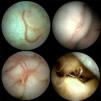A 68-year-old man presented with the complaint of hematochezia for 2 months. The results of hematological examinations showed red blood cell count 2.43×1012/L, hemoglobin 4.86g/dL, white blood cell count 3.99×109/L (including 11.5% eosinophil granulocyte) and positive pancreatic autoantibodies (PABs). Esophagogastroduodenoscopy (EGD), colonoscopy and radiographic contrast studies of intestine were normal. After obtaining the patient's consent, we performed capsule endoscopy. Capsule endoscopy confirmed many hookworms in small intestine (Fig. 1). Mebendazole was administered, at follow-up, hematochezia was resolved after mebendazole use for 3 days, but melena persisted for about 1 week as for the ulcers caused by hookworms. Hemoglobin level improved as a result of taking iron supplements, the patient had a complete remission in 3 months.
Obscure gastrointestinal bleeding (OGIB) is defined as occult or overt bleeding of unknown origin that persists or recurs after an initial negative endoscopic evaluation including colonoscopy and EGD. The introduction of capsule endoscopy over the past decade has had a major impact in the diagnosis of OGIB. This tool is particularly useful for establishing the source of bleeding in obscure bleeders, which is often the small intestine—a notoriously difficult site to examine.1 Parasite is a rare cause of OGIB.2 Occasionally, the potential association between positive PABs hookworm infestation, as seen for the first time in this patient warrants further investigation.
Conflict of interestAll authors declare to have no conflict of interest.







